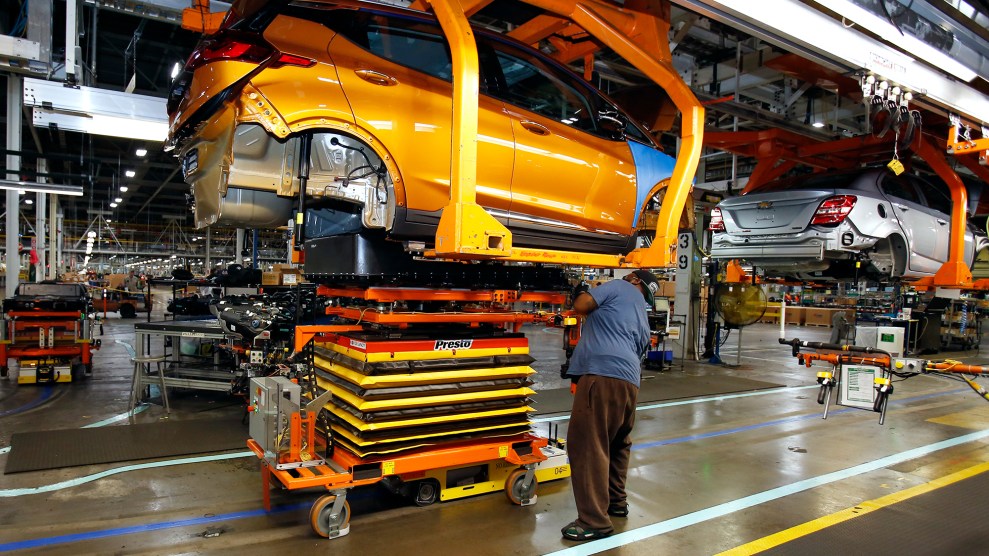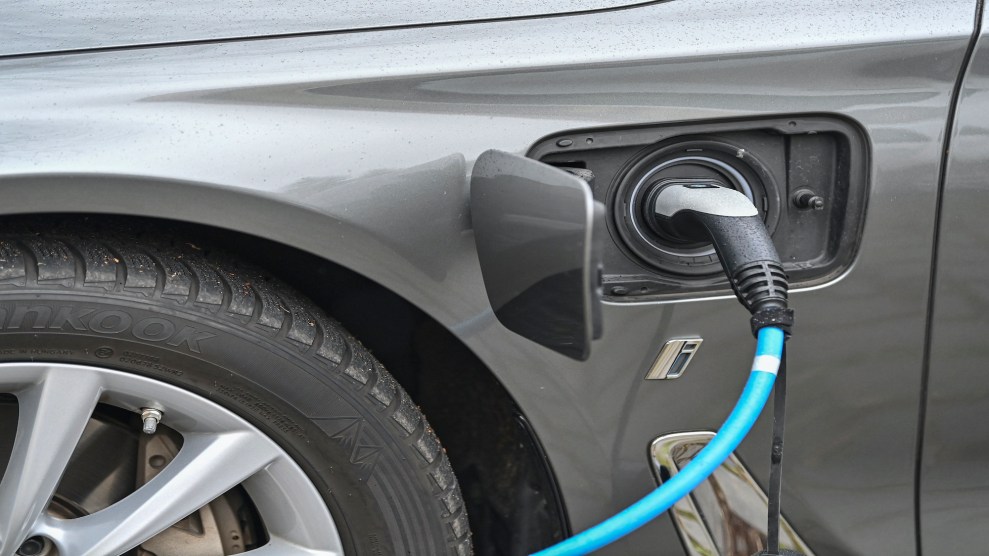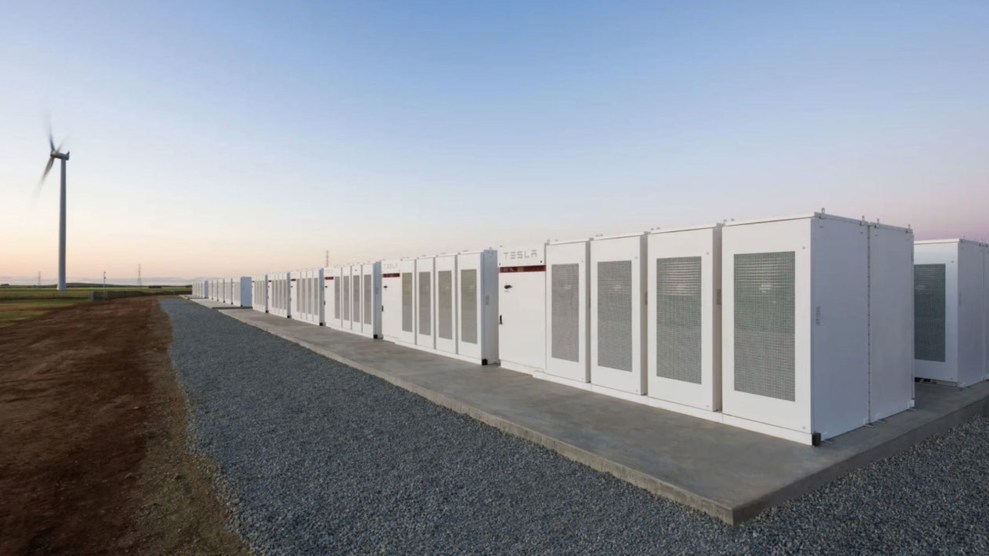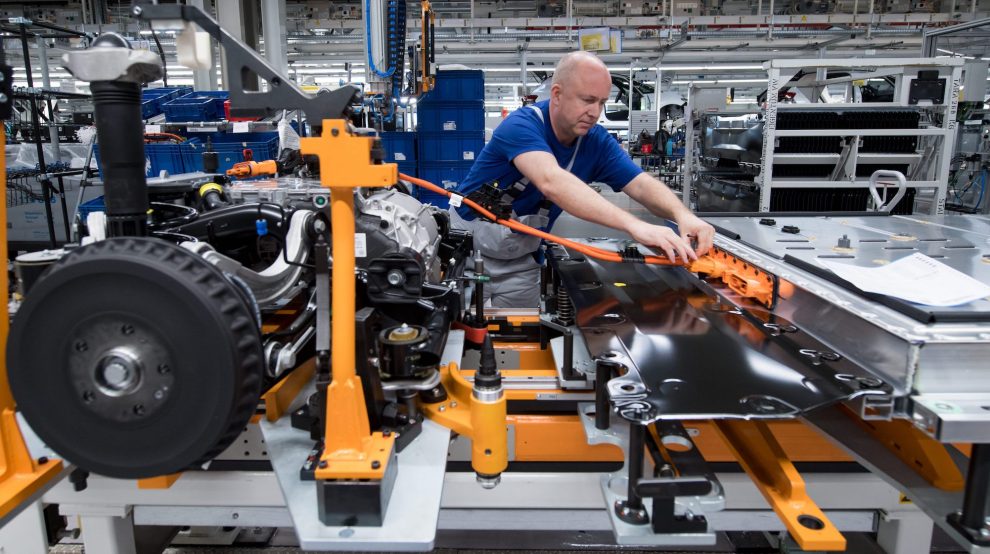
A worker guides a battery pack into the chassis of a Chevrolet Bolt at General Motors Orion Assembly plant. Nov. 4, 2016, Duane Burleson/AP
This story was originally published by Wired and is reproduced here as part of the Climate Desk collaboration.
The history of battery science is filled with short circuits, explosions—and, occasionally, tales of redemption. One of these is the story of the lithium-iron-phosphate battery.
LFP, as it’s known, (the “F” refers to the Latin name for iron) was discovered as a good battery material in the University of Texas lab of John Goodenough. He was (and is, at 99) a legendary battery scientist, best known for designing the cathode—the crystal structure that catches and releases lithium ions as the battery charges and gets used—that led to the first commercial lithium-ion battery in 1991. LFP, coming a few years after that, seemed to have many advantages over its predecessor. The cathode was stable and long-lasting, and potentially well-suited to powering electric cars. And unlike Goodenough’s previous cathode, it did not depend on cobalt, a relatively pricey metal, but rather on run-of-the-mill iron.
But when Venkat Srinivasan began working on LFP as a postdoc in the early 2000s, his advisors suggested he think about doing something else. “They said, ‘Why are you bothering with this?’” he recalls. For all its promise, LFP did not appear to have a bright future. The government was trying hard to cultivate an LFP battery industry alongside a new market for electric cars, pouring money into the cause. But electric cars weren’t taking off as quickly as hoped, so there was barely a market for batteries to power them. Meanwhile, LFP was being overtaken by newer battery recipes that combined cobalt with nickel to pack more energy.
How odd it is then that 20 years later LFP is everywhere. Thank Elon Musk. Over the past year, the Tesla CEO has announced a major shift to the older battery chemistry—a necessity, in large part, because batteries are now in such high demand that the industry is headed for a materials supply cliff composed largely of nickel and cobalt. Tesla’s partner in this endeavor is CATL, the massive battery maker in China, where the technology was tended to over the years and quietly flourished, improving to the point that LFP batteries can now suitably power a family sedan. Like most of the major cathode chemistries still in use today, the battery was developed in a US or European lab, but its future is squarely in China, which today manufactures 90 percent of LFP battery cells, according to Benchmark Minerals. For the US, “LFP is a missed opportunity,” Srinivasan says.
Srinivasan, who is now head of Argonne National Lab’s Collaborative Center for Energy Storage Science, leads a US government initiative intended to prevent similar misses. Called Li-Bridge, the program was formed this fall after the Biden Administration set a goal of making 50 percent of new car sales electric. The administration has said the US is putting too much stake in battery technology that could only come from overseas—particularly China. Automakers also fear a situation similar to the current microchip supply crisis, which is forcing them to desperately jockey to be at the front of the queue as fresh chips come off the line. “The last thing I want to be doing is to negotiate with the Asian nations to ensure supply,” Robert Schilp, Ford’s director of purchasing for electric vehicles, warned at a conference last month. “We need to get it here.” If not, that means US automakers may end up selling fewer EVs than customers want.
There are signs that the battery industry is heeding its own warning. Last month, GM and Posco Chemicals, a Korean cathode materials company, announced plans for a US factory to produce cathode materials. In Europe, where the battery industry is not much further ahead, Volkswagen has partnered with the Belgian materials company Umicore. In September, Redwood Materials, a company perhaps best known for recycling battery materials, announced that it was also getting into the cathode-making business with plans to build a US factory that will produce enough cathodes for 5 million electric vehicles by 2030. It’s a start, Srinivasan says: “For every announcement that’s made, that’s fantastic. Now we just need 20 more of them.”
Until recently, more momentum in the US has been directed toward factories that assemble battery cells. This is one of the final steps before the battery heads off to an automaker. But the crux of the manufacturing remains earlier in the process—especially producing the materials for the cathode, which makes up the largest portion of a battery’s cost and also its carbon emissions. That’s largely due to just how far the atoms that end up inside that cathode must travel before they reach a car. First they must zig-zag thousands of miles across the world and pass through many sets of hands, from miners to processors and refiners to the manufacturers that make powdered cathode materials.
Some of those steps are easier to bring close to home than others. The locations where these minerals are dug up? Those are pretty much fixed. The bulk of the world’s cobalt comes from the Democratic Republic of the Congo, while nickel is extracted from places like Russia and Indonesia, and battery makers engage in bidding wars for rights to lithium sourced from Andean brines. The US has small reserves of nickel and cobalt (on Monday Tesla announced it had committed to buying both from a proposed mine in northern Minnesota), as well as more substantial sources of lithium that have stirred environmental concerns and may take years to get up and running.
Automakers can have some say over which materials are important by choosing which cathodes end up in their cars. But the trade-offs can be tricky to navigate, Srinivasan says, and even small changes in cathode chemistry can mean a radically different supply chain. Pushing for lower-cobalt batteries often means more demand for nickel, for example. It may also require an entirely new lithium supply chain because of the way the new material is manufactured. (For the record, battery makers will want it in the form of lithium hydroxide, not lithium carbonate, because it decomposes at a lower temperature.)
A popular choice for US automakers facing materials constraints are those high-nickel, low-cobalt cathodes because they allow automakers to pack more range into vehicle batteries than switching to LFP would. “When it comes to energy density, there’s no better metal than nickel,” says Alan Nelson, Redwood’s senior vice president for battery materials. For Redwood, which plans to manufacture those types of cathodes, the design makes particular sense, he says, because the company’s approach of using recycled materials means it will not need to rely on any outside sources of cobalt—an enviable position in the industry. The company will, however, need to find raw sources of nickel, mostly likely from mines abroad.
One advantage China has in building up battery manufacturing is that it also leads the US and Europe in demand for electric vehicles, says Hans Eric Melin, founder of Circular Energy Storage, a battery consultancy. “Where is everything happening? Where are the resources? Where are the leaders?” Melin asks. That could also have an influence on who leads with new battery technologies, he notes, by making it far easier for Chinese battery makers to try out and scale up new formulations. He points to last year’s announcement that CATL would make a major push into producing sodium-ion batteries for cars, closing the circuit on yet another old and nearly forgotten technology that was developed largely in Europe and taking it big.
China’s demand advantage is especially true for shorter-range cars that use LFP batteries, says Nikos Tsafos, an energy and geopolitics expert at the Center for Strategic and International Studies. But the US could make up that gap, he suggests. If the Biden administration has a strategic goal of reducing US dependence on cobalt and nickel, perhaps it should do more to encourage that. Maybe cars with LFP batteries should come with a sweeter tax credit for buyers. “It doesn’t seem very useful to have a target and then a set of policies that aren’t attuned to that target,” he says. “You could say, ‘Hey, not all batteries are the same.’”
The US could also work to avoid another miss on emerging technology. Srinivasan of Li-Bridge points out that the US leads on research into new technologies like silicon anodes and solid-state electrolytes, which experts hope will lead to batteries that are substantially more powerful and long-lasting than existing ones. But success isn’t just a matter of a breakthrough in a lab, he notes. It also means having a plan to invest ahead of time in the parts of the supply chain that will actually get those new batteries built—figuring out what mundane components a new battery design will require and what rare minerals will suddenly need to be sourced at high volumes. The perfect recipe for a solid-state battery could very well involve a dash of zirconium, or a sprinkle of vanadium. As Srinivasan puts it, “Where do you get zirconium, again?”















